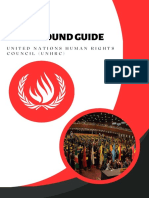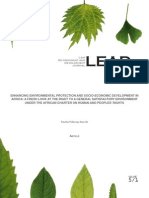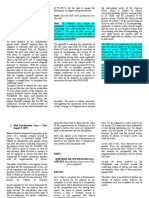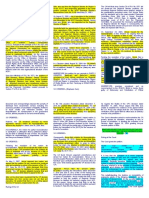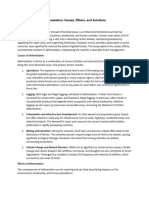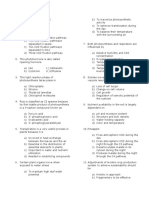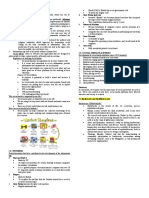The United Nations Mandate On Human Rights and The Environment
The United Nations Mandate On Human Rights and The Environment
Uploaded by
Mikaela PamatmatCopyright:
Available Formats
The United Nations Mandate On Human Rights and The Environment
The United Nations Mandate On Human Rights and The Environment
Uploaded by
Mikaela PamatmatOriginal Title
Copyright
Available Formats
Share this document
Did you find this document useful?
Is this content inappropriate?
Copyright:
Available Formats
The United Nations Mandate On Human Rights and The Environment
The United Nations Mandate On Human Rights and The Environment
Uploaded by
Mikaela PamatmatCopyright:
Available Formats
The United Nations mandate on human rights and the environment
John H Knox
Henry C Lauerman Professor of International Law, Wake Forest University
In 2012, the UN Human Rights Council decided for the first time to appoint an independent
expert to study the human rights obligations relating to the enjoyment of a safe, clean, healthy,
and sustainable environment. I had the honor of receiving the appointment later that year. Over
the next six years, first as an independent expert and then as a special rapporteur, I held
consultations, issued reports, visited countries, received communications, and conducted other
activities aimed at clarifying and strengthening the application of human rights law to
environmental issues. At the conclusion of my term, I presented the Framework Principles on
Human Rights and the Environment, which set out the fundamental human rights norms relating
to the environment. In 2018, my successor, David Boyd, and I also proposed that the United
Nations recognize the human right to a healthy environment.
The Human Rights Council is the principal UN human rights body. Composed of 47
states selected by the General Assembly, it often appoints experts to focus on particular issues of
human rights. Most of the mandates are thematic, created to address a particular right (e.g., the
right to freedom of expression or the right to health), a particular type of abuse (e.g., torture or
extrajudicial killings), or a particular segment of the human population (e.g., indigenous peoples
or migrants). Some mandates focus on individual countries. Country mandates are renewable on
an annual basis and thematic mandates every three years.
The mandate-holders, or ‘special procedures’, as they are called within the United
Nations, are required to pursue their mandates in accordance with the resolutions adopted by the
Council, but otherwise they are independent. They may not receive instructions from
governments or the UN Secretariat, they are not UN employees, and they are not paid a salary.
Their independence means that they are not subject to the political constraints that bind the
Council, which is usually reluctant to criticize states too harshly. The special procedures
therefore play an invaluable role within the UN system. Their powers are limited – in particular,
Electronic copy available at: https://ssrn.com/abstract=3367206
they have no authority to issue binding decisions – but they are able to use their positions to
investigate and call attention to human rights abuses, amplifying the concerns of marginalized
individuals and communities that might otherwise go unheard.
In most cases, the special rapporteurs construe human rights obligations that are already
clearly defined. The work of the special rapporteurs on the right to health, on torture, and on
indigenous peoples, for example, is guided by the human rights instruments addressing those
issues and identifying specific duties on the part of states. Occasionally, however, the Council
appoints an expert whose task is to clarify a relatively undeveloped or understudied corner of
human rights law. For example, the Council decided in 2008 to appoint Catarina de
Albuquerque, a Portuguese law professor, to examine the human rights obligations relating to
access to safe drinking water and sanitation. The rights to water and sanitation were not
explicitly included in global human rights treaties, such as the International Covenant on
Economic, Social and Cultural Rights, but it had become widely understood that the rights were
integral to other rights, including the rights to life, health, and an adequate standard of living.
The work of the independent expert helped to provide a basis for the recognition by the General
Assembly, two years later, of the human rights to safe and clean drinking water and sanitation.1
Because the Human Rights Council now has more than 50 active mandates, the decision
to add another mandate may seem somewhat routine. However, the decision to create a mandate
to study the relationship of human rights and the environment came only after two decades of
failed efforts to convince UN intergovernmental conferences and bodies to take this step. As
other chapters in this volume explain, many national and international human rights bodies have
long been actively engaged in recognizing and applying the human right to a healthy
environment, as well as other human rights, to a host of environmental issues. The United
Nations was slow to join this growing field, hampered in part by the absence of the right to a
healthy environment in the UN human rights treaties. The decision of the Council to establish a
mandate on human rights and the environment signaled a new level of commitment to
understanding how human rights norms apply in the environmental context.
1
UN General Assembly res. 64/292 (July 28, 2010).
Electronic copy available at: https://ssrn.com/abstract=3367206
After reviewing the history of efforts to raise the issue at the United Nations, this chapter
describes the work of the author as the first UN mandate-holder on human rights and the
environment from 2012, when the Council created the mandate, to 2018, when the special
rapporteur presented the Framework Principles on Human Rights and the Environment and urged
the Council to support formal recognition by the UN General Assembly of the human right to a
healthy environment.
Efforts to link human rights and the environment at the United Nations before 2012
The seminal United Nations human rights instruments, including the Universal Declaration of
Human Rights, the International Covenant on Economic, Social and Cultural Rights, and the
International Covenant on Civil and Political Rights, do not mention a right to a healthy
environment. This omission is especially striking in light of the widespread adoption of the right
at the regional and national levels. Almost every regional human rights instrument recognizes the
right, as do more than 100 national constitutions.2 The reason for the omission seems, at least on
its face, to be unfortunate timing: the General Assembly adopted the Universal Declaration in
1948 and the Covenants in 1966, before the rise of the modern environmental movement.
However, it is harder to explain the failure of the United Nations to recognize the right
since then. Perhaps the closest the international community has come to global recognition of the
right was the declaration adopted at the first United Nations environmental conference, held in
2
See African Charter on Human and Peoples’ Rights, June 27, 1981, in force October 21, 1986, 1520 UNTS 217,
art 24; Additional Protocol to the American Convention on Human Rights in the Area of Economic, Social and
Cultural Rights: Protocol of San Salvador, November 17, 1988, in force November 16, 1999, 28 ILM 161, art 11(1);
Arab Charter on Human Rights, May 22, 2004, in force March 15, 2008, 12 IHRR 893 (2005), art 38; Association of
Southeast Asian Nations (ASEAN) Human Rights Declaration, November 18, 2012, art 28(f). The San Salvador
Protocol and the Arab Charter each refer to a ‘healthy’ environment; the Arab Charter refers to a ‘satisfactory’
environment, and the ASEAN Declaration uses the terms ‘safe, clean and sustainable’. See also Aarhus Convention
on Access to Information, Public Participation in Decision-Making and Access to Justice in Environmental Matters,
June 25, 1998, in force October 21, 2001, 2161 UNTS 447, art 1 (stating that the parties are required to guarantee
the rights of access to information, public participation in decision-making, and access to justice in environmental
matters ‘[i]n order to contribute to the protection of the right of every person of present and future generations to
live in an environment adequate to his or her health and well-being’).
Electronic copy available at: https://ssrn.com/abstract=3367206
Stockholm in 1972. Principle 1 of the Stockholm Declaration states that ‘man has the
fundamental right to freedom, equality and adequate conditions of life, in an environment of a
quality that permits a life of dignity and well-being’.3 Twenty years later, the UN Conference on
Environment and Development softened this language, stating in the Rio Declaration only that
human beings ‘are entitled to a healthy and productive life in harmony with nature’.4
International conferences on sustainable development in Johannesburg in 2002 and Rio de
Janeiro in 2012 also failed to recognize the right.
One might expect that UN human rights bodies would be more appropriate forums for the
recognition of a new human right. Until 2006, the main incubator of human rights norms at the
United Nations was the Commission on Human Rights, which drafted the Universal Declaration,
the Covenants, and many other treaties and declarations. (In 2006, the General Assembly
replaced the Commission with the Human Rights Council.) In 1989, at the behest of a US
environmental group, the Sierra Club Legal Defense Fund (which later changed its name to
Earthjustice), the Sub-Commission for the Prevention and Protection of Minorities, a body of
nominally independent experts that reported to the Commission on Human Rights, began to
consider the relationship of human rights and the environment. The Sub-Commission appointed
one of its members, Fatma-Zohra Ksentini, as its special rapporteur on the topic. In her final
report, in 1994, Ksentini presented a draft declaration of principles on human rights and the
environment, which described the right of all persons to a ‘secure, healthy and ecologically
sound environment’, and included many related rights, including ‘the right to freedom from
pollution’, ‘the right to protection and preservation of the air, soil, water, sea-ice, flora and fauna,
and the essential processes and areas necessary to maintain biological diversity and ecosystems’,
‘the right to safe and healthy food and water adequate to their well-being’, and ‘the right to
information concerning the environment’.5
3
Declaration of the UN Conference on the Human Environment, UN Doc. A/Conf.48/14/Rev.1 (June 5–16, 1972).
4
Rio Declaration on Environment and Development, UN Doc. A/CONF.151/26/Rev.1, annex I (June 14, 1992). See
Shelton (1993), pp. 75–93.
5
Fatma Zohra Ksentini, Final Report, UN Doc. E/CN.4/Sub.2/1994/9, annex III (July 6, 1994).
Electronic copy available at: https://ssrn.com/abstract=3367206
In August 1994, the Sub-Commission transmitted the draft declaration to the Commission
and recommended that the Commission appoint a special rapporteur on human rights and the
environment. At the next session of the Commission, in March 1995, Cuba introduced a
resolution on human rights and the environment that would have appointed a special rapporteur,
but the United Kingdom and the United States, among others, opposed the proposal.6 The
Commission eventually adopted a softened version of the Cuban proposal that did not include the
creation of a new mandate; instead, the Commission merely asked the Secretary-General to
publicize the Ksentini report.7
During the same period, a coalition of African governments pursued a more limited and
ultimately more successful effort to raise awareness of the effects of the illegal dumping of toxic
waste on human rights. In 1995, at the same session that rejected the Cuban suggestion for a
special rapporteur on human rights and the environment, the Commission created a mandate on
toxic dumping and appointed Ksentini to be the first special rapporteur.8 Even this step was
controversial, however; developed countries argued that environmental issues should be
addressed only in environmental institutions.9
The Commission returned to the broader topic of human rights and the environment in
2001, during the preparation for the 2002 World Summit on Sustainable Development in
Johannesburg. At the request of South Africa, the Commission requested the Office of the High
Commissioner for Human Rights (OHCHR) and the UN Environment Programme (UNEP) to
hold a joint seminar to review progress since the 1992 Rio Conference with respect to
‘promoting and protecting human rights in relation to environmental questions’.10 In 2003, the
6
For an analysis of the North-South divisions on this issue in the Commission at the time, see Limon (2018).
7
Commission on Human Rights res. 1995/14.
8
Commission on Human Rights res. 1995/81.
9
See Dennis (1998). Over time, however, the mandate became less contentious. See Gwam (2002). The mandate
has been regularly extended, and its scope has been expanded to cover toxic and hazardous substances generally.
The current special rapporteur is Baskut Tuncak.
10
Commission on Human Rights dec. 2001/111.
Electronic copy available at: https://ssrn.com/abstract=3367206
Commission adopted a more detailed resolution, entitled ‘human rights and the environment as
part of sustainable development’.11 Among other things, the resolution called upon states to ‘take
all necessary and appropriate measures to protect the exercise of everyone’s human rights when
promoting environmental protection and sustainable development’, and emphasized that states
should take into account ‘how environmental degradation may affect all members of society,
including individuals and groups of individuals who are victims of or subject to racism’. The
Commission adopted a similar resolution in 2005,12 but any further work by it on this issue was
cut off in 2006, when the Commission was replaced by the Human Rights Council.
Two years later, in March 2008, the Council adopted the first of what became a series of
resolutions on human rights and climate change. Sparked by the Maldives, Costa Rica, and
Switzerland, the resolutions were designed to increase awareness of the threats posed by climate
change to the enjoyment of a broad range of rights, including the rights to life and health. By
requesting reports by OHCHR and providing for panel discussions at Council sessions, the
resolutions helped to provide a basis for human rights concerns to be raised in climate forums,
including the negotiation of an agreement on climate change.13 These efforts bore fruit in
December 2015 with the inclusion of an explicit reference to human rights in the preamble to the
Paris Agreement, the first such reference in any global environmental agreement.14
Some states suggested that the Council should appoint a special rapporteur on human
rights and climate change, but it seemed clear that such an effort could not command a consensus
on the Council. Rather than push the Council to establish the mandate with a divided vote, the
Maldives and like-minded governments decided to pursue a broader mandate on human rights
and the environment. As described later by one of the diplomats involved, they decided that what
was needed was
11
Commission on Human Rights res. 2003/71.
12
Commission on Human Rights res. 2005/60.
13
See Limon, supra.
14
See Knox, The Paris Agreement as a Human Rights Treaty (2018); Rajamani (2018).
Electronic copy available at: https://ssrn.com/abstract=3367206
a norm-clarifying and norm-defining effort, at the Council, to understand more precisely
how human rights principles and commitments might be applied to international and
national environmental policy, including climate change policy. In other words, the main
sponsors wanted to move beyond general debates between States on the presence and
nature of the relationship between human rights and environment, to a more practical
exercise premised on setting out the norms and, ultimately, working with all relevant
stakeholders to apply those norms internationally and domestically.15
In March 2012, the Council decided to appoint an independent expert to ‘study the human rights
obligations relating to the enjoyment of a safe, clean, healthy and sustainable environment’, and
to ‘identify, promote and exchange views on best practices relating to the use of human rights
obligations … to inform, support and strengthen environmental policymaking’.16 The present
author was appointed in July, at the next Council session, and formally took the position on
August 1, 2012.
The first term of the UN mandate on human rights and the environment: 2012–2015
The main focus of the mandate in its first three years was to study the human rights obligations
relating to the enjoyment of a safe, clean, healthy and sustainable environment. In the absence of
a globally recognized human right to a healthy environment, human rights bodies had ‘greened’
existing human rights, applying rights to life, health, an adequate standard of living, and many
others to environmental issues. The result was the creation of an extensive environmental
jurisprudence. In my role as the independent expert, I sought to map this jurisprudence by
identifying and organizing exactly what human rights bodies had said about the environment.
With the assistance of attorneys and academics working pro bono, I published 14 reports
15
Limon, supra.
16
Human Rights Council res. 19/10 (March 22, 2012), para 2.
Electronic copy available at: https://ssrn.com/abstract=3367206
compiling the statements of international bodies on how the rights within their purview applied
to environmental issues.17
Each report describes the relevant statements of a particular body or set of bodies. Five
reports examine global human rights treaties, focusing on the interpretations of the treaties by the
independent experts charged with their oversight. Other reports describe the jurisprudence of
regional human rights tribunals, including the European Court of Human Rights, the Inter-
American Commission and Court of Human Rights, and the African Commission on Human and
Peoples’ Rights. Still other reports look at statements by UN human rights mechanisms,
including special rapporteurs and the Human Rights Council itself. Finally, one set of reports
examines international environmental instruments, including the Rio Declaration, the Aarhus
Convention, and a number of other multilateral environmental agreements.
At the same time, I held a series of regional consultations, with the support of the United
Nations Environment Programme. Each consultation focused on a particular thematic issue. For
example, the first consultation, in February 2013, in Nairobi, addressed procedural obligations;
the second, held in Geneva later that year, was on substantive obligations; the third, in Panama
City, was on obligations relating to those in vulnerable situations; and so forth. These
consultations provided many more examples of how human rights norms were being brought to
bear on environmental issues.
The mapping project revealed that, despite the wide differences in the scope and
jurisdiction of the human rights bodies addressing environmental issues, they had reached
remarkably similar conclusions about the relationship of human rights and the environment.
First, they had universally agreed that environmental harm can and does interfere with the full
enjoyment of a vast range of human rights, including the rights to life, health, food, water,
housing, and many others. Second, human rights bodies had concluded that states have specific
obligations to protect people from such environmental harm.
17
The reports are available at http://srenvironment.org/mapping-report-2014-2/ and
http://www.ohchr.org/EN/Issues/Environment/SREnvironment/Pages/MappingReport.aspx.
Electronic copy available at: https://ssrn.com/abstract=3367206
In March 2014, I presented a report to the Human Rights Council describing those
obligations.18 The report makes clear that not all states have formally accepted all of these
norms, and that while some of the statements are from treaties, or from tribunals that have the
authority to issue decisions that bind the states subject to their jurisdiction, other statements are
interpretations by experts that do not in themselves have binding effect. Nevertheless, the
statements ‘provide strong evidence of converging trends towards greater uniformity and
certainty in the human rights obligations relating to the environment’, and the report encourages
states to accept the statements as evidence of actual or emerging international law or, at a
minimum, as best practices that states should move to adopt as expeditiously as possible.19
The obligations described in the report include procedural duties, substantive duties and
duties in relation to those who are particularly vulnerable to environmental harm. The procedural
obligations include obligations: (a) to assess environmental impacts and make environmental
information public; (b) to facilitate public participation in environmental decision-making; and
(c) to provide access to effective remedies for environmental harm. These obligations are often
considered to correspond to civil and political rights, but in the environmental context they have
been derived from the full range of human rights whose enjoyment is threatened by
environmental harm, including rights to health, food and water.
Closely related to the obligation to facilitate public participation are the obligations to
respect and protect the rights of freedom of expression and of peaceful assembly and association.
Individuals have rights to speak out against or in favor of proposed policies that would affect the
environment on which they depend. Human rights bodies have emphasized that governments
must protect environmental defenders when they are subject to threats, refrain from placing
restrictions that would hinder the performance of their work, and conduct serious and effective
investigations of any violations against them.20
18
UN Doc. A/HRC/25/53 (December 30, 2013).
19
Ibid, paras 27, 28.
20
See, e.g., Inter-American Court of Human Rights, Kawas-Fernandez v Honduras, ¶ 145 (2009). Unfortunately,
governments often fail to comply with these obligations. Environmental defenders are at great risk of harassment,
9
Electronic copy available at: https://ssrn.com/abstract=3367206
States also have substantive obligations to protect against environmental harm that
interferes with the enjoyment of human rights, including when the harm is caused by
corporations and other non-state actors. The report states that the obligation to protect human
rights from environmental harm does not require the cessation of all activities that may cause any
environmental degradation. States have discretion to strike a balance between environmental
protection and other issues of societal importance, such as economic development and the rights
of others. However, the balance cannot be unreasonable or result in unjustified, foreseeable
infringements of human rights. In determining whether an environmental law has struck a
reasonable balance, relevant factors include whether it meets national and international health
standards and whether it is non-retrogressive. There is a strong presumption that retrogressive
measures are not permissible. Moreover, once a state has adopted environmental standards into
its law, it must implement and comply with those standards.
Finally, States must not discriminate against groups on prohibited grounds in the
application of their environmental laws and policies, and they must take additional steps to
protect those who are particularly vulnerable to environmental harm. These obligations are
developed in most detail with respect to indigenous peoples who, because of their close
relationship with the environment, are particularly vulnerable to impairment of their rights
through environmental harm. States have duties, among others, to recognize the rights of
indigenous peoples in the territories they have traditionally occupied, to allow extractive
activities within those territories only with their free, prior, and informed consent, and to ensure
that they receive a reasonable benefit from any development in their territories.
In response to the mapping report, the Human Rights Council adopted a resolution in
March 2014 recognizing that
violence, and even murder. Since 2014, the human rights organization Global Witness has issued a series of reports
finding that approximately four environmental and land defenders are killed every week. The first report, which
reviews killings between 2002 and 2013, is at https://www.globalwitness.org/en/campaigns/environmental-
activists/deadly-environment/. See generally John H Knox, Environmental Human Rights Defenders: A Global
Crisis (January 2017).
10
Electronic copy available at: https://ssrn.com/abstract=3367206
human rights law sets out certain obligations on States that are relevant to the enjoyment
of a safe, clean, healthy and sustainable environment, and that the enjoyment of the
corresponding human rights and fundamental freedoms can be facilitated by assessing
environmental impact, making environmental information public and enabling effective
participation in environmental decision-making processes, and that in that regard a good
practice includes adopting, strengthening and implementing laws and other measures to
promote and protect human rights and fundamental freedoms in the context of
environmental legislation and policies.21
The Council urged states to ‘comply with their human rights obligations when developing and
implementing their environmental policies’.22
The following year, in 2015, I concluded the first three-year term of the mandate by
presenting a report to the Council compiling more than 100 good practices in the use of the
human rights obligations identified in the mapping report.23 The Council then decided to renew
the mandate for another three years.24 It changed the title of the mandate-holder from
independent expert to special rapporteur, and it asked me to promote and report on the realization
of the human rights obligations relating to the environment and to identify challenges and
obstacles to their full realization, as well as to continue to study obligations and identify good
practices in their use.25 By shifting the focus of the mandate more towards compliance, the
21
Human Rights Council res. 25/21, para 4 (March 28, 2014).
22
Ibid, para 8.
23
UN Doc. A/HRC/28/61 (February 3, 2015). A one-page summary of each good practice is available at the website
of the Office of the High Commissioner for Human Rights (OHCHR), and at a dedicated website,
http://environmentalrightsdatabase.org, which allows the practices to be easily searched by type and region. The
summary of each practice includes its implementing actors and location, a brief description of the practice, and links
to websites where further information about the practice may be found.
24
Human Rights Council Res. 28/11 (March 26, 2015).
25
Ibid, para 5.
11
Electronic copy available at: https://ssrn.com/abstract=3367206
Council indicated that the obligations in this area were now clear enough that states could be
expected to implement them.
The second term of the mandate: 2015–2018
The second term of the mandate proceeded along two tracks: the continued clarification of
human rights norms with respect to specific environmental issues; and promotion of compliance
and implementation of human rights obligations relating to the environment.
On the first track, the mandate focused on one issue each year. The first of these issues
was climate change, which had long been of special interest to many governments on the
Council. In 2014 and 2015, the application of human rights norms to climate change was of
particular importance as governments negotiated what eventually became the Paris Agreement,
adopted in December 2015 at the 21st Conference of the Parties to the UN Framework
Convention on Climate Change. I and other mandate-holders issued a number of statements and
reports on climate change and human rights. For example, on December 10, 2014, Human Rights
Day, which fell during the twentieth session of the Conference of the Parties, all of the mandate-
holders issued a statement urging that the climate agreement then under negotiation include
language stating that the parties ‘shall, in all climate change related actions, respect, protect,
promote, and fulfil human rights for all’, and underscoring that ‘human rights must be pivotal in
the ongoing negotiations and the new agreement must be firmly anchored in the human rights
framework’. In the spring of 2015, I and some other special rapporteurs issued a joint report
describing the adverse effects on human rights that would follow from even a two-degree
increase in global average temperature.
Governments urging a stronger target in the negotiations cited this report to support their
position, which was eventually reflected in article 2 of the Paris Agreement. Article 2 states the
aim of the parties to hold the increase in temperature to well below 2°C above pre-industrial
levels and to pursue efforts to limit the temperature increase to 1.5°C. In addition, the Paris
Agreement includes a strong reference to human rights in the preamble, although not as strong as
the language proposed by the rapporteurs the previous year.
12
Electronic copy available at: https://ssrn.com/abstract=3367206
In March 2016, I presented a report to the Council on climate change and human rights,
which gives the Paris Agreement mixed marks. The report states that the target of holding the
temperature increase to well below two degrees is consistent with the obligations of states to
protect human rights from the dangerous effects of climate change, but it points out that the
actual commitments of states under the agreement will fail to reach that target. The report
concludes that ‘even if they meet their current commitments, States will not satisfy their human
rights obligations’, and therefore ‘it is necessary not only to implement the current intended
contributions, but also to strengthen those contributions to meet the target set out in article 2 of
the Paris Agreement’.26
The following year I prepared a thematic report on the relationship of biological diversity
and human rights. Drawing on scientific studies showing the fundamental importance of
biodiversity for human health and well-being, the report states that:
the full enjoyment of human rights, including the rights to life, health, food and water,
depends on the services provided by ecosystems. The provision of ecosystem services
depends on the health and sustainability of ecosystems, which in turn depend on
biodiversity. The full enjoyment of human rights thus depends on biodiversity, and the
degradation and loss of biodiversity undermine the ability of human beings to enjoy their
human rights.27
While the loss of biodiversity threatens the human rights of everyone, it has particularly grave
effects for those who depend most closely on the natural environment for their material and
cultural needs, including indigenous peoples and traditional communities. The report describes
the human rights obligations of states with respect to those who are particularly vulnerable and
the obligations that states have to protect biodiversity generally. The report emphasizes that
states are failing to meet their own targets for conserving biodiversity, with potentially disastrous
consequences for human life and well-being.
26
UN Doc. A/HRC/31/52 (February 1, 2016), paras 76, 77.
27
UN Doc. A/HRC/34/49 (January 19, 2017), para 5.
13
Electronic copy available at: https://ssrn.com/abstract=3367206
The most recent thematic report, presented to the Council in March 2018, addresses
children’s rights and the environment.28 Building on the work of many others, the report explains
that children are especially vulnerable to environmental threats. Indeed, more than 1.5 million
children under the age of five die annually because of pollution and other avoidable
environmental harm. The report describes how environmental degradation interferes with the
ability of children to enjoy their human rights, including their rights to life, health and
development, to an adequate standard of living, and to play and recreation. The report also
describes the obligations of states, including their duties to provide for environmental education,
to develop and disseminate information about environmental threats to children, to consider the
views of children in environmental decision-making, and to provide for effective remedies for
environmental harm to children. The report emphasizes that states’ discretion to strike a balance
between environmental protection and other societal goals is more limited with respect to
environmental harm to children, because the consequences of such harm are usually far more
severe for them, and because children are typically excluded from environmental decision-
making, even with respect to decisions that will primarily affect them. States must therefore take
additional steps to protect children, including by conducting child-rights assessments of proposed
policies and actions.
The second track of the mandate after 2015 has been to promote implementation of the
human rights obligations relating to the environment. In March 2016, I presented a report to the
Council proposing a number of specific steps to implement the norms.29 The Council adopted a
resolution encouraging states to adopt many of the suggested methods, including to:
• ‘facilitate the exchange of knowledge and experiences between experts in the
environmental and human rights fields, and to promote coherence among different policy
areas’;
28
UN Doc. A/HRC/37/58 (January 24, 2018).
29
UN Doc. A/HRC/31/53 (December 28, 2015).
14
Electronic copy available at: https://ssrn.com/abstract=3367206
• ‘explore ways to incorporate information on human rights and the environment, including
climate change, in school curricula, in order to teach the next generations to act as agents
of change, including by taking into account indigenous knowledge’;
• ‘seek to ensure that projects supported by environmental finance mechanisms respect all
human rights’;
• ‘collect disaggregated data on the effects of environmental harm on vulnerable groups, as
appropriate’;
• ‘build capacity for the judicial sector to understand the relationship between human rights
and the environment’; and
• ‘foster a responsible private business sector and to encourage corporate sustainability
reporting while protecting environmental standards in accordance with relevant
international standards and agreements and other ongoing initiatives in this regard’.30
To facilitate implementation at the domestic level, I worked closely with UNEP and other
partners to hold regional workshops for national judges on the implementation of constitutional
environmental rights.31 In addition, together with other mandate-holders, I sent many
communications to governments requesting that they respond to alleged human rights violations
in relation to the environment. I also undertook country visits, including to Madagascar,
Mongolia and Uruguay.32
The Framework Principles on Human Rights and the Environment
The final major project was to prepare the Framework Principles on Human Rights and the
Environment, which are designed to clearly and succinctly set out the basic obligations of states
under human rights law as they relate to the enjoyment of a safe, clean, healthy and sustainable
30
Human Rights Council res. 31/8, para. 5 (March 23, 2016).
31
The workshops were held in South Africa in April 2016, in Brazil in May 2017, and in Pakistan in February 2018.
32
UN Docs. A/HRC/34/49/Add.1 (Madagascar); A/HRC/37/58/Add.1 (Uruguay); A/HRC/37/58/Add.2 (Mongolia).
15
Electronic copy available at: https://ssrn.com/abstract=3367206
environment.33 Each Framework Principle has a commentary that elaborates on it and further
clarifies its meaning. The Principles do not create new obligations. Rather, the Principles and
commentary provide practical guidance on how human rights obligations should be implemented
in the environmental context.
The first two Framework Principles express the basic interdependence of human rights
and environmental protection. Principle One provides that ‘States should ensure a safe, clean,
healthy and sustainable environment in order to respect, protect and fulfil human rights’, and
Principle Two that ‘States should respect, protect and fulfil human rights in order to ensure a
safe, clean, healthy and sustainable environment’.
A number of the Framework Principles address procedural obligations. Responding to the
increasing threats to environmental defenders around the world, Framework Principle Four
makes clear that ‘States should provide a safe and enabling environment in which individuals,
groups and organs of society that work on human rights or environmental issues can operate free
from threats, harassment, intimidation and violence’. Framework Principle Five provides that
‘States should respect and protect the rights to freedom of expression, association and peaceful
assembly in relation to environmental matters’. Principles Six through Ten describe states’
obligations to: provide for education and public awareness on environmental matters; provide
public access to environmental information; require the prior assessment of the possible
environmental impacts of proposed projects and policies, including their potential effects on the
enjoyment of human rights; provide for and facilitate public participation in decision-making
related to the environment; and provide for access to effective remedies for violations of human
rights and domestic laws relating to the environment.
Framework Principle Eleven states that ‘States should establish and maintain substantive
environmental standards that are non-discriminatory, non-retrogressive and otherwise respect,
protect and fulfil human rights’. The accompanying commentary lists factors that human rights
bodies have taken into account in this respect, including that:
33
The Framework Principles are in an annex to UN Doc. A/HRC/37/59 (January 24, 2018).
16
Electronic copy available at: https://ssrn.com/abstract=3367206
• the standards should result from a procedure that complies with human rights obligations;
• the standards should take into account and, to the extent possible, be consistent with all
relevant international environmental, health and safety standards;
• the standards should take into account the best available science;
• the standards must, of course, comply with all relevant human rights obligations; and
• the standards must not strike an unjustifiable or unreasonable balance between
environmental protection and other social goals.
Framework Principle Twelve provides that states should ensure the effective enforcement of the
standards against public and private actors.
At the international level, Principle Thirteen states that ‘States should cooperate with each
other to establish, maintain and enforce effective international legal frameworks in order to
prevent, reduce and remedy transboundary and global environmental harm that interferes with the
full enjoyment of human rights’.
The Framework Principles also include obligations to those who are most vulnerable to
environmental harm. Principle Three provides that ‘States should prohibit discrimination and
ensure equal and effective protection against discrimination in relation to the enjoyment of a
safe, clean, healthy and sustainable environment’. This language covers direct and indirect
discrimination, and the commentary provides examples of both in the environmental context.
Principle Fourteen states that ‘States should take additional measures to protect the rights of
those who are most vulnerable to, or at particular risk from, environmental harm, taking into
account their needs, risks and capacities’. The commentary provides examples of such measures,
including: developing disaggregated data on the specific effects of environmental harm on
different segments of the population; assessing the impacts on the most vulnerable as part of the
environmental assessment of proposed projects; and putting measures in place to ensure the
equitable and effective participation of all affected segments of the population in the relevant
decision-making. Framework Principle Fifteen says that States should ensure that they comply
with their obligations to indigenous peoples and members of traditional communities, including,
among other things, by consulting with them and obtaining their free, prior, and informed
17
Electronic copy available at: https://ssrn.com/abstract=3367206
consent before relocating them or taking or approving any other measures that may affect their
lands, territories or resources.
Finally, Framework Principle Sixteen concludes by stating that ‘States should respect,
protect and fulfil human rights in the actions they take to address environmental challenges and
pursue sustainable development.’ This language makes clear that the obligations of States under
human rights law apply even when states are adopting and implementing measures to address
environmental challenges and to pursue sustainable development.
Next steps: time for UN recognition of the human right to a healthy environment?
In my final report to the Human Rights Council, I explained that while explicit recognition of the
human right to a healthy environment has not been necessary for the development of human
rights norms relating to the environment, it is nevertheless significant that the great majority of
the countries in the world have recognized the right at the national or regional level, or both.34
The report reviews some of the advantages of adopting such a right, based on the experience of
these countries, including that it has raised the profile and importance of environmental
protection and provided a basis for the enactment of stronger environmental laws. When applied
by the judiciary, it has helped to provide a safety net to protect against gaps in statutory laws and
created opportunities for better access to justice.
On the basis of this experience, I recommended that the Council consider supporting the
recognition of the human right to a healthy environment in a global instrument. I pointed out that
a model could be the 2010 General Assembly resolution recognizing the rights to water and
sanitation. The content of those rights had been largely developed before the formal recognition
of the right, due to the work of the Committee on Economic, Social and Cultural Rights and the
then-independent expert on the right to water. Similarly, I explained that the human right to a
healthy environment ‘is not an empty vessel waiting to be filled; on the contrary, its content has
already been clarified, through recognition by human rights authorities that a safe, clean, healthy
34
UN Doc. A/HRC/37/59 (January 24, 2018), para 13.
18
Electronic copy available at: https://ssrn.com/abstract=3367206
and sustainable environment is necessary for the full enjoyment of the human rights to life,
health, food, water, housing and so forth’.35 The recognition of the right would serve as a simple,
clear statement that would capture the meaning of the existing obligations, as described in the
Framework Principles.
The extension of the mandate
In March 2018, the Council decided to extend the mandate for another three years.36 Proposed
initially by a group of countries including Costa Rica, Maldives, Morocco, Slovenia and
Switzerland, the resolution eventually had over 80 co-sponsors and was adopted by consensus.
The near-universal political support for the resolution illustrates how far governments have come
in recognizing and understanding the relationship of human rights and the environment. At the
same time, the content of the resolution indicates that some states are still uncomfortable with the
idea of recognizing a human right to a healthy environment.
In the resolution, the Council welcomed the work of the special rapporteur and took note with
appreciation of his reports, and it called on states to ‘implement fully their obligations to respect
and ensure human rights without distinction of any kind, including in the application of
environmental laws and policies’, but the Council did not endorse the Framework Principles or
respond to the call for recognition of a human right to a healthy environment.37 However, the
Council did request the new special rapporteur to report for the first time to the General
Assembly as well as to the Human Rights Council. The report to the General Assembly is
significant because it provides an opportunity for the special rapporteur to raise awareness of the
relationship between human rights and the environment with a broader audience.
In July 2018, the Council appointed David R. Boyd, a professor of law at the University
of British Columbia, to carry out the mandate for the next three years. In October 2018, in his
35
Ibid, para 15.
36
Human Rights Council res. 37/8 (March 22, 2018), para 6..
37
Ibid, paras 1–3.
19
Electronic copy available at: https://ssrn.com/abstract=3367206
first presentation to the General Assembly, he urged the United Nations to recognize the human
right to a healthy environment, a recognition that is long overdue.
Conclusion
In the evolving relationship between human rights and the environment, the decision by the UN
Human Rights Council to create a mandate on the topic has been an important development. It
has helped to build a political consensus at the United Nations that human rights and
environmental protection are interdependent; it has clarified the human rights obligations relating
to the enjoyment of a safe, clean, healthy and sustainable environment; and it has promoted
better compliance with those obligations. Finally, it may prove to be another step towards the
global recognition of the human right to a healthy environment.
20
Electronic copy available at: https://ssrn.com/abstract=3367206
You might also like
- Envi Sci AssessmentDocument4 pagesEnvi Sci AssessmentMary Grace MahusayNo ratings yet
- Biodiversity WorksheetDocument2 pagesBiodiversity WorksheetJazmin Sanchez IbarraNo ratings yet
- Group 4 - Peaceful Concerted ActivitiesDocument15 pagesGroup 4 - Peaceful Concerted ActivitiesMikaela Pamatmat100% (3)
- Udhr Human Rights Law Essay Final VersionDocument16 pagesUdhr Human Rights Law Essay Final VersionPrathamesh PaiNo ratings yet
- SP Protecting Sacred Natural Sites IndigenousDocument21 pagesSP Protecting Sacred Natural Sites Indigenouskamarajme2006No ratings yet
- (BOOK) Behavioral Ecology of Tropical Birds PDFDocument169 pages(BOOK) Behavioral Ecology of Tropical Birds PDFTecto Fakhriga Q100% (1)
- Moeckli Chapter 19Document59 pagesMoeckli Chapter 19asdfg12345No ratings yet
- Air Pollution Chapter 5Document51 pagesAir Pollution Chapter 5Salman QureshiNo ratings yet
- Environmental Degradation & Human RightsDocument71 pagesEnvironmental Degradation & Human Rightslovelybansal890No ratings yet
- Application of The Rules of Procedure For Environmental CasesDocument55 pagesApplication of The Rules of Procedure For Environmental CasesEnno De AsisNo ratings yet
- Seminor Paper Full SheetDocument7 pagesSeminor Paper Full Sheetkeerthikasureshrajanba.llbNo ratings yet
- 17 - Chapter 9Document36 pages17 - Chapter 9akilasriNo ratings yet
- 08 03 HumanrightsDocument11 pages08 03 HumanrightsVikingsaucyNo ratings yet
- Project - Human RightsDocument10 pagesProject - Human Rightssrikant sirkaNo ratings yet
- The Right To A Satisfactory Environ-Ment and The African CommissionDocument18 pagesThe Right To A Satisfactory Environ-Ment and The African CommissionUtibe basseyNo ratings yet
- EVS ProjectDocument20 pagesEVS ProjectDhananjay SoodNo ratings yet
- General Assembly: United NationsDocument15 pagesGeneral Assembly: United NationsSociedad y Discapacidad - SodisNo ratings yet
- Empire Hechime Nyekwere, The Emergence of Environmental Human Rights Under International Law, Third Issue, IRHRLDocument30 pagesEmpire Hechime Nyekwere, The Emergence of Environmental Human Rights Under International Law, Third Issue, IRHRLPulak SymonNo ratings yet
- Boyd Effectiveness of Constitutional Environmental RightsDocument32 pagesBoyd Effectiveness of Constitutional Environmental RightsmakauNo ratings yet
- Alao Adedolapo Human Right Seminar PaperDocument30 pagesAlao Adedolapo Human Right Seminar PaperAlao AdedolapoNo ratings yet
- International Institute For Environment and DevelopmentDocument5 pagesInternational Institute For Environment and DevelopmentPen ValkyrieNo ratings yet
- Tanveer 10Document8 pagesTanveer 10kansari7452No ratings yet
- Unit 15Document19 pagesUnit 15ram.kishorNo ratings yet
- CESCR Fact SheetDocument22 pagesCESCR Fact SheetJay GeeNo ratings yet
- Chapter 2: The International Human Rights Framework Te Whare Tika Tangata o Te AoDocument10 pagesChapter 2: The International Human Rights Framework Te Whare Tika Tangata o Te AoElgieraydolph BuisonNo ratings yet
- Human Rights Assignment.Document7 pagesHuman Rights Assignment.Gredward Kaches FolotiyaNo ratings yet
- 2024 G12 Cve Updated Notes - SouthernDocument9 pages2024 G12 Cve Updated Notes - Southernmwashingweleyolanta7No ratings yet
- Lectures 3&4Document7 pagesLectures 3&4jotadeNo ratings yet
- Right To Health Under The IcescrDocument17 pagesRight To Health Under The IcescrDamcelle TorresNo ratings yet
- environmental_law_is_an_obligation_erga_omnes_emerging_interamcthradvisoryopinionjune2018Document7 pagesenvironmental_law_is_an_obligation_erga_omnes_emerging_interamcthradvisoryopinionjune2018longyan0915No ratings yet
- Sept 30 2020 Letter To Dean Iacobucci of University of Toronto Law SchoolDocument3 pagesSept 30 2020 Letter To Dean Iacobucci of University of Toronto Law SchoolSamantha MandelesNo ratings yet
- Evirornt As Thired Gener RightDocument6 pagesEvirornt As Thired Gener RightHanamariam FantuNo ratings yet
- HumanrightsDocument30 pagesHumanrightsMohsin KhanNo ratings yet
- 2024 g12 Cve Updated Notes - SouthernDocument9 pages2024 g12 Cve Updated Notes - SouthernTama RäNo ratings yet
- Stephen SONDEM NATIONAL HUMAN RIGHTS INSTITUTIONS - THE GHANAIAN EXPERIENCEDocument17 pagesStephen SONDEM NATIONAL HUMAN RIGHTS INSTITUTIONS - THE GHANAIAN EXPERIENCECentre for Regional Policy Research and Cooperation StudiorumNo ratings yet
- Understanding Human Rights: July 2020Document7 pagesUnderstanding Human Rights: July 2020Lunar WalkerNo ratings yet
- Chapter-3 International Legal Frame Work and Standards For The Protection of Children From Sexual OffencesDocument70 pagesChapter-3 International Legal Frame Work and Standards For The Protection of Children From Sexual Offenceskartik kasniaNo ratings yet
- Human Rights Law-JurisprudenceDocument113 pagesHuman Rights Law-JurisprudencelaizerjobethNo ratings yet
- Environment and Human Rights Issues National and International PerspectiveDocument23 pagesEnvironment and Human Rights Issues National and International PerspectiveScheherazade SandhuNo ratings yet
- Note On Ethiopian Environmental LawDocument6 pagesNote On Ethiopian Environmental LawAdamseged Eyasu100% (1)
- Optional Protocols To The International Bill of Human RightsDocument16 pagesOptional Protocols To The International Bill of Human RightsRaja Sanmanbir SinghNo ratings yet
- Vasavi MUN 2023 - UNHRCDocument16 pagesVasavi MUN 2023 - UNHRCShaik AliyaNo ratings yet
- Universal Declaration of Animal RightsDocument23 pagesUniversal Declaration of Animal RightsFernando De Azevedo Alves BritoNo ratings yet
- MYP5 I - S U2 Notes Human - RightsDocument4 pagesMYP5 I - S U2 Notes Human - RightsVirenNo ratings yet
- Audrey R. Chapman : Oxford University PressDocument22 pagesAudrey R. Chapman : Oxford University Pressscann2No ratings yet
- Chapter 16 - Human Rights and Environment (2006)Document3 pagesChapter 16 - Human Rights and Environment (2006)SuiNo ratings yet
- The Enforcement of International Human Rights LawDocument8 pagesThe Enforcement of International Human Rights Lawkomalmohan.mohanNo ratings yet
- Human Rights Rain SemesterDocument12 pagesHuman Rights Rain Semesters98515952No ratings yet
- Classification of Human Rights851053 - 1590040888Document5 pagesClassification of Human Rights851053 - 1590040888nupursingha02No ratings yet
- Legal EnglishDocument5 pagesLegal EnglishFedericaNo ratings yet
- UN Human RightsDocument4 pagesUN Human RightsJerome ChuaNo ratings yet
- The Right To A Clean and Healthy EnvironmentDocument7 pagesThe Right To A Clean and Healthy EnvironmentpaulNo ratings yet
- HUMAN RIGHTS AND THE ENVIRONMENT Environmental LawDocument39 pagesHUMAN RIGHTS AND THE ENVIRONMENT Environmental LawNobody Of ConsequenceNo ratings yet
- Human Rights and Environment PaperDocument25 pagesHuman Rights and Environment PaperThet Su100% (1)
- Emeka AmechiDocument19 pagesEmeka AmechiEmeka Polycarp AmechiNo ratings yet
- Pau 3104: Human Rights & Gender: Prof. J. MwimaliDocument9 pagesPau 3104: Human Rights & Gender: Prof. J. MwimaliGeneti TemesgenNo ratings yet
- PILDocument17 pagesPILShella CregenciaNo ratings yet
- Project United Nations and Human RightsDocument34 pagesProject United Nations and Human Rightsviral bhanushaliNo ratings yet
- Assignment on Human rights & Law enforcementDocument34 pagesAssignment on Human rights & Law enforcementRobiul Alam SifatNo ratings yet
- Law and PovertyDocument24 pagesLaw and Povertyuma mishraNo ratings yet
- Disabled Persons, Senior Citizens, Minorities, and Human RightsDocument6 pagesDisabled Persons, Senior Citizens, Minorities, and Human RightsSrestha DasNo ratings yet
- International and Regional Human RightsDocument127 pagesInternational and Regional Human RightssuakelloNo ratings yet
- Akinyemi AFRICANCHARTERHUMAN 1985Document33 pagesAkinyemi AFRICANCHARTERHUMAN 1985Tawana ChelseaNo ratings yet
- Bayer Phils. Versus Agana, G.R. No. L38701 April 8, 1975: FactsDocument51 pagesBayer Phils. Versus Agana, G.R. No. L38701 April 8, 1975: FactsMikaela PamatmatNo ratings yet
- Pinga V. Heirs of Santiago GR No. 170354 Facts:: Ex ParteDocument11 pagesPinga V. Heirs of Santiago GR No. 170354 Facts:: Ex ParteMikaela PamatmatNo ratings yet
- SCA CasesDocument33 pagesSCA CasesMikaela PamatmatNo ratings yet
- Sps. Huang v. LBPDocument18 pagesSps. Huang v. LBPMikaela PamatmatNo ratings yet
- G Other CasesDocument86 pagesG Other CasesMikaela PamatmatNo ratings yet
- Gorg 2 DigestDocument8 pagesGorg 2 DigestMikaela PamatmatNo ratings yet
- Esteves v. SarmientoDocument34 pagesEsteves v. SarmientoMikaela PamatmatNo ratings yet
- Digest Titan V DavidDocument3 pagesDigest Titan V DavidMikaela PamatmatNo ratings yet
- Digests FinalDocument12 pagesDigests FinalMikaela PamatmatNo ratings yet
- Arigo v. Swift (Pamatmat)Document3 pagesArigo v. Swift (Pamatmat)Mikaela PamatmatNo ratings yet
- Labor Reviewer - WagesDocument22 pagesLabor Reviewer - WagesMikaela Pamatmat100% (1)
- Galang v. WallisDocument2 pagesGalang v. WallisMikaela PamatmatNo ratings yet
- CCFOP v. AquinoDocument3 pagesCCFOP v. AquinoMikaela PamatmatNo ratings yet
- CCFOP v. AquinoDocument3 pagesCCFOP v. AquinoMikaela PamatmatNo ratings yet
- Land Bank v. Atlanta IndustriesDocument3 pagesLand Bank v. Atlanta IndustriesMikaela PamatmatNo ratings yet
- 112 Mandanas v. Executive Secretary OchoaDocument2 pages112 Mandanas v. Executive Secretary OchoaMikaela Pamatmat100% (1)
- PPT - Adaptation in Plants - NewDocument78 pagesPPT - Adaptation in Plants - Newpriyal sherekarNo ratings yet
- Environmental LeadershipDocument4 pagesEnvironmental LeadershipElpi FerrerNo ratings yet
- Biology and EcologyDocument5 pagesBiology and EcologykarennNo ratings yet
- Priority Sites For Conservation in The Philippines: Key Biodiversity AreasDocument24 pagesPriority Sites For Conservation in The Philippines: Key Biodiversity AreasDenise FontanillaNo ratings yet
- Human-Bird Conflicts and Management Issues in IndiaDocument12 pagesHuman-Bird Conflicts and Management Issues in IndiaShihab KhaledinNo ratings yet
- Water Resources-Mind Map and GEO CH2-Full ContentDocument10 pagesWater Resources-Mind Map and GEO CH2-Full Content[33] Shaai Shankar.SNo ratings yet
- BMRCL R6 EIA ReportDocument110 pagesBMRCL R6 EIA ReportmilanNo ratings yet
- Terraformation - The Global Seed Bank IndexDocument40 pagesTerraformation - The Global Seed Bank IndexZlatan AngNo ratings yet
- About These Lesson Plans and ResourcesDocument8 pagesAbout These Lesson Plans and ResourcesAhmer TariqNo ratings yet
- Unit 2Document6 pagesUnit 2Gulnara AbeshovaNo ratings yet
- Environmental CrisisDocument20 pagesEnvironmental Crisismacsolution833No ratings yet
- Treasured Landscapes, Unforgettable ExperiencesDocument28 pagesTreasured Landscapes, Unforgettable ExperiencesSir TemplarNo ratings yet
- Deforestation Causes, Effects, and SolutionsDocument3 pagesDeforestation Causes, Effects, and Solutionspolash.tscNo ratings yet
- Grade 12 BiologyDocument6 pagesGrade 12 BiologyabhijitNo ratings yet
- Submission-Environmental LawDocument43 pagesSubmission-Environmental LawOishi SenNo ratings yet
- Crop ScienceDocument13 pagesCrop ScienceSean HooeksNo ratings yet
- Report 2013-14Document41 pagesReport 2013-14Kannan RamaiahNo ratings yet
- Emca 1999Document38 pagesEmca 1999THABANJA0% (1)
- Inheritors of The Earth How Nature Is Thriving in An Age of Extinction by Chris D. ThomasDocument328 pagesInheritors of The Earth How Nature Is Thriving in An Age of Extinction by Chris D. ThomasSeu Madruga MadrugaNo ratings yet
- Effective Management PDFDocument1 pageEffective Management PDFekaasemNo ratings yet
- Diversity 14 00539 v2Document20 pagesDiversity 14 00539 v2Indri WulandariNo ratings yet
- STS Module 5-6Document3 pagesSTS Module 5-6なるNo ratings yet
- Step by Step GuideDocument55 pagesStep by Step GuideAmila BrajićNo ratings yet
- Be (Cse)Document217 pagesBe (Cse)Mary ThummaNo ratings yet
- Policy & Trends in Regenerative AgricultureDocument18 pagesPolicy & Trends in Regenerative AgricultureMohamed HeshamNo ratings yet
- ENVS-AECC-2-ENVS 2021 Vu QuestionDocument3 pagesENVS-AECC-2-ENVS 2021 Vu QuestionRajani Kanta Dolai100% (1)










































